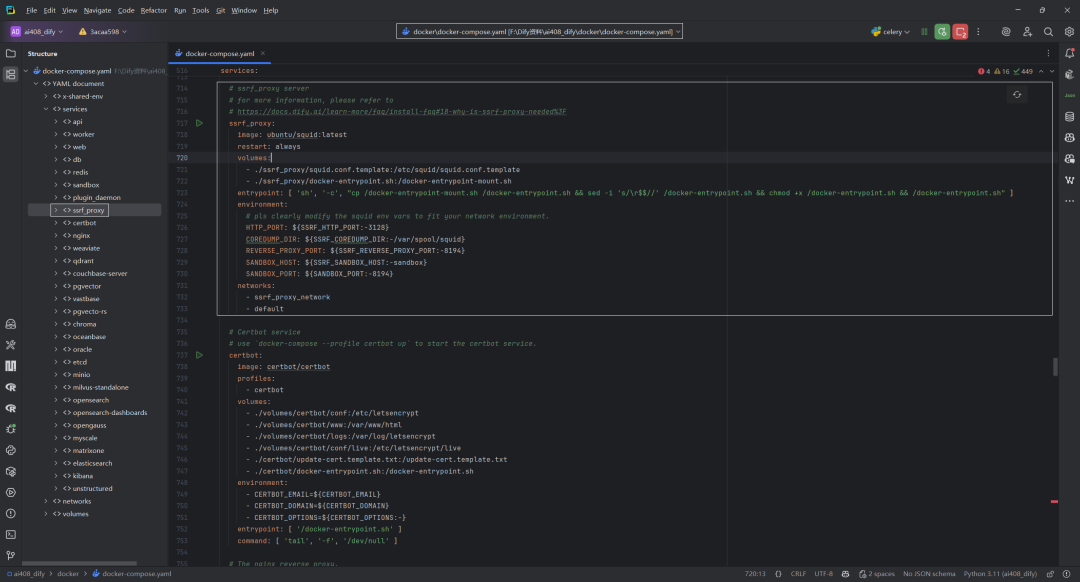本文使用Dify v1.5.0版本,主要介绍了Dify中的SSRF_PROXY。为什么需要SSRF_PROXY,可参考Dify官方文档的FAQ[2]。简单理解,为了防止SSRF(服务器端请求伪造)。

一.ssrf_proxy服务
1.ssrf_proxy配置
文件位置:dify/docker/docker-compose.yaml
# ssrf_proxy server
# for more information, please refer to
# https://docs.dify.ai/learn-more/faq/install-faq#18-why-is-ssrf-proxy-needed%3F
ssrf_proxy:
image: ubuntu/squid:latest
restart: always
volumes:
- ./ssrf_proxy/squid.conf.template:/etc/squid/squid.conf.template
- ./ssrf_proxy/docker-entrypoint.sh:/docker-entrypoint-mount.sh
entrypoint: [ 'sh', '-c', "cp /docker-entrypoint-mount.sh /docker-entrypoint.sh && sed -i 's/\r$$//' /docker-entrypoint.sh && chmod +x /docker-entrypoint.sh && /docker-entrypoint.sh" ]
environment:
# pls clearly modify the squid env vars to fit your network environment.
HTTP_PORT: ${SSRF_HTTP_PORT:-3128}
COREDUMP_DIR: ${SSRF_COREDUMP_DIR:-/var/spool/squid}
REVERSE_PROXY_PORT: ${SSRF_REVERSE_PROXY_PORT:-8194}
SANDBOX_HOST: ${SSRF_SANDBOX_HOST:-sandbox}
SANDBOX_PORT: ${SANDBOX_PORT:-8194}
networks:
- ssrf_proxy_network
- default
下面解析这段 docker-compose.yml 片段,说明每个字段在 Dify 的 ssrf_proxy 服务中扮演的角色。
| 配置字段 | 解释 |
|---|---|
|
|
|
|
|
|
|
|
|
|
|
|
|
|
|
|
|
|
|
|
|
(1)API/Worker/插件 需要访问外网 → 强制设定 HTTP_PROXY=http://ssrf_proxy:3128;
(2)请求进入Squid,根据在squid.conf.template定义的ACL白名单与带宽/请求大小限制决定是否放行;
(3)如需内部回调(例如访问sandbox:8194执行沙箱代码),Squid利用SANDBOX_HOST与 REVERSE_PROXY_PORT 转发;
(4)合规流量被转发、记录,非法或超限流量被拒绝或限速。
这样即可在 不修改应用代码 的前提下,为所有外部 HTTP 调用加上统一的 SSRF 防护和流量治理层。
2.ssrf_proxy网络
当一个服务同时连接到ssrf_proxy_network和default网络时,实现了两种不同的网络通信能力,这是一种平衡安全性和可访问性的架构设计。
networks:
# create a network between sandbox, api, worker and ssrf_proxy, and can not access outside.
ssrf_proxy_network:
driver:bridge
internal:true
(1)内部安全通信
通过ssrf_proxy_network网络,该服务可以与其它连接到这个网络的服务(如sandbox、api、worker或ssrf_proxy)进行安全通信。
-
这是一个
internal: true的网络,确保这些通信不会访问外网 -
主要用于需要安全隔离的服务间通信
(2)外部网络访问
通过default网络(默认网络,无需创建),服务可访问互联网,与其它连接到default网络但没有连接到ssrf_proxy_network的服务通信。
3.ssrf_proxy环境变量
文件位置:dify\docker\.env
SSRF是一种安全漏洞,通过这个代理可以防止恶意请求访问内部资源。配置SSRF(服务器端请求伪造)代理的环境变量部分,如下所示:
-
SSRF_HTTP_PORT=3128:设置SSRF代理的HTTP端口为3128(常见的Squid代理默认端口) -
SSRF_COREDUMP_DIR=/var/spool/squid:指定Squid代理的核心转储文件存储目录 -
SSRF_REVERSE_PROXY_PORT=8194:设置反向代理的端口号 -
SSRF_SANDBOX_HOST=sandbox:指定沙箱环境的主机名 -
SSRF_DEFAULT_TIME_OUT=5:设置默认的总体超时时间为5秒 -
SSRF_DEFAULT_CONNECT_TIME_OUT=5:设置连接超时时间为5秒 -
SSRF_DEFAULT_READ_TIME_OUT=5:设置读取超时时间为5秒 -
SSRF_DEFAULT_WRITE_TIME_OUT=5:设置写入超时时间为5秒
这些配置主要用于控制代理服务器的行为和性能,同时提供安全保护,防止通过应用程序访问未授权的内部资源。
二.squid.conf.template配置文件解析
文件位置:dify/docker/ssrf_proxy/squid.conf.template
acllocalnetsrc0.0.0.1-0.255.255.255# RFC 1122 "this" network (LAN)
acllocalnetsrc10.0.0.0/8# RFC 1918 local private network (LAN)
acllocalnetsrc100.64.0.0/10# RFC 6598 shared address space (CGN)
acllocalnetsrc169.254.0.0/16# RFC 3927 link-local (directly plugged) machines
acllocalnetsrc172.16.0.0/12# RFC 1918 local private network (LAN)
acllocalnetsrc192.168.0.0/16# RFC 1918 local private network (LAN)
acllocalnetsrcfc00::/7# RFC 4193 local private network range
acllocalnetsrcfe80::/10# RFC 4291 link-local (directly plugged) machines
aclSSL_portsport443
# acl SSL_ports port 1025-65535 # Enable the configuration to resolve this issue: https://github.com/langgenius/dify/issues/12792
aclSafe_portsport80# http
aclSafe_portsport21# ftp
aclSafe_portsport443# https
aclSafe_portsport70# gopher
aclSafe_portsport210# wais
aclSafe_portsport1025-65535# unregistered ports
aclSafe_portsport280# http-mgmt
aclSafe_portsport488# gss-http
aclSafe_portsport591# filemaker
aclSafe_portsport777# multiling http
aclCONNECTmethodCONNECT
aclallowed_domainsdstdomain.marketplace.dify.ai
http_accessallowallowed_domains
http_accessdeny!Safe_ports
http_accessdenyCONNECT!SSL_ports
http_accessallowlocalhostmanager
http_accessdenymanager
http_accessallowlocalhost
include/etc/squid/conf.d/*.conf
http_accessdenyall
################################## Proxy Server ################################
http_port${HTTP_PORT}
coredump_dir${COREDUMP_DIR}
refresh_pattern^ftp:144020%10080
refresh_pattern^gopher:14400%1440
refresh_pattern-i(/cgi-bin/|\?)00%0
refresh_pattern\/(Packages|Sources)(|\.bz2|\.gz|\.xz)$00%0refresh-ims
refresh_pattern\/Release(|\.gpg)$00%0refresh-ims
refresh_pattern\/InRelease$00%0refresh-ims
refresh_pattern\/(Translation-.*)(|\.bz2|\.gz|\.xz)$00%0refresh-ims
refresh_pattern.020%4320
# cache_dir ufs /var/spool/squid 100 16 256
# upstream proxy, set to your own upstream proxy IP to avoid SSRF attacks
# cache_peer 172.1.1.1 parent 3128 0 no-query no-digest no-netdb-exchange default
################################## Reverse Proxy To Sandbox ################################
http_port${REVERSE_PROXY_PORT}accelvhost
cache_peer${SANDBOX_HOST}parent${SANDBOX_PORT}0no-queryoriginserver
aclsrc_allsrcall
http_accessallowsrc_all
# Unless the option's size is increased, an error will occur when uploading more than two files.
client_request_buffer_max_size100MB
1.网络访问控制列表(ACL)定义
(1)本地网络定义
acl localnet src 0.0.0.1-0.255.255.255# RFC 1122 "this" network (LAN)
acl localnet src 10.0.0.0/8# RFC 1918 local private network (LAN)
acl localnet src 100.64.0.0/10# RFC 6598 shared address space (CGN)
acl localnet src 169.254.0.0/16# RFC 3927 link-local (directly plugged) machines
acl localnet src 172.16.0.0/12# RFC 1918 local private network (LAN)
acl localnet src 192.168.0.0/16# RFC 1918 local private network (LAN)
acl localnet src fc00::/7# RFC 4193 local private network range
acl localnet src fe80::/10# RFC 4291 link-local (directly plugged) machines
-
定义了
localnetACL,包含各种本地和私有网络IP范围 -
包括RFC标准定义的各种本地网络地址段和IPv6地址范围
(2)端口访问控制
aclSSL_portsport443
# acl SSL_ports port 1025-65535 # Enable the configuration to resolve this issue: https://github.com/langgenius/dify/issues/12792
aclSafe_portsport80# http
aclSafe_portsport21# ftp
aclSafe_portsport443# https
aclSafe_portsport70# gopher
aclSafe_portsport210# wais
aclSafe_portsport1025-65535# unregistered ports
aclSafe_portsport280# http-mgmt
aclSafe_portsport488# gss-http
aclSafe_portsport591# filemaker
aclSafe_portsport777# multiling http
-
第1行:定义
SSL_portsACL,允许443端口(HTTPS) -
第2行:被注释掉的配置,可解决GitHub issue #12792
-
第3-12行:定义
Safe_portsACL,列出所有允许访问的端口 -
包括常见服务端口如80(HTTP)、21(FTP)等
-
包括非注册端口范围1025-65535
(3)其它ACL定义
acl CONNECT method CONNECT
acl allowed_domains dstdomain .marketplace.dify.ai
-
定义CONNECT方法的ACL
-
定义允许访问的域名ACL(marketplace.dify.ai)
2.访问控制规则
http_access allow allowed_domains
http_access deny !Safe_ports
http_access deny CONNECT !SSL_ports
http_access allow localhost manager
http_access deny manager
http_access allow localhost
include /etc/squid/conf.d/*.conf
http_access deny all
-
允许访问已定义的允许域名
-
拒绝访问非安全端口
-
拒绝CONNECT方法连接到非SSL端口
-
本地主机访问管理接口的规则
-
包含外部配置文件
-
最后拒绝所有其他访问请求
3.代理服务器配置
################################## Proxy Server ################################
http_port ${HTTP_PORT}
coredump_dir ${COREDUMP_DIR}
refresh_pattern ^ftp: 144020% 10080
refresh_pattern ^gopher: 14400% 1440
refresh_pattern -i (/cgi-bin/|\?) 00% 0
refresh_pattern \/(Packages|Sources)(|\.bz2|\.gz|\.xz)$ 00% 0 refresh-ims
refresh_pattern \/Release(|\.gpg)$ 00% 0 refresh-ims
refresh_pattern \/InRelease$ 00% 0 refresh-ims
refresh_pattern \/(Translation-.*)(|\.bz2|\.gz|\.xz)$ 00% 0 refresh-ims
refresh_pattern . 020% 4320
-
设置HTTP代理端口(使用环境变量)
-
设置核心转储目录
-
定义不同类型内容的缓存刷新模式
-
包括FTP、Gopher等协议的缓存策略
-
软件包相关文件的特殊缓存处理
4.注释掉的缓存配置
# cache_dir ufs /var/spool/squid 100 16 256
# upstream proxy, set to your own upstream proxy IP to avoid SSRF attacks
# cache_peer 172.1.1.1 parent 3128 0 no-query no-digest no-netdb-exchange default
-
缓存目录配置(已注释)
-
上游代理设置(已注释),用于防止SSRF攻击
5.反向代理配置
这部分 Squid 配置设置了一个反向代理,用于连接到Sandbox环境。
################################## Reverse Proxy To Sandbox ################################
http_port ${REVERSE_PROXY_PORT} accel vhost
cache_peer ${SANDBOX_HOST} parent ${SANDBOX_PORT} 0 no-query originserver
acl src_all src all
http_access allow src_all
(1)http_port ${REVERSE_PROXY_PORT} accel vhost 配置
-
设置 Squid 在
${REVERSE_PROXY_PORT}环境变量指定的端口上监听 -
accel表示启用加速器/反向代理模式 -
vhost启用虚拟主机支持,允许处理多个域名的请求
(2)cache_peer ${SANDBOX_HOST} parent ${SANDBOX_PORT} 0 no-query originserver 配置:
-
定义 Squid 应该将请求转发到哪里
-
${SANDBOX_HOST}是沙盒服务器的主机名/IP -
parent表示 Squid 与目标服务器的关系类型 -
${SANDBOX_PORT}是沙盒服务器的端口号 -
0表示 ICP 端口(0 表示不使用 ICP) -
no-query禁用对此缓存对等体的 ICP 查询 -
originserver表示此对等体是原始服务器(非缓存)
这个配置使 Squid 作为反向代理,接收来自 ${REVERSE_PROXY_PORT} 的请求并将其转发到 ${SANDBOX_HOST}:${SANDBOX_PORT}的沙盒服务器。
(3)acl src_all src all和http_access allow src_all
创建了一个名为 src_all 的访问控制列表(ACL),该列表匹配所有来源IP地址。src all 表示匹配任何客户端IP地址。允许上面定义的 src_all ACL中的所有IP地址访问代理服务器。
注解:
配置的组合效果是:允许来自任何IP地址的请求通过这个Squid代理服务器。在反向代理到沙盒环境的配置部分中,这意味着所有客户端请求都将被允许转发到定义的沙盒服务器。这是一个非常开放的配置,通常用于内部网络或受控环境中。在生产环境中应谨慎使用,除非有其它安全措施限制对代理服务器的访问。
6.其它设置
增加客户端请求缓冲区大小到100MB,避免上传多文件时出错。
# Unless the option's size is increased, an error will occur when uploading more than two files.
client_request_buffer_max_size 100 MB
三.docker-entrypoint.sh脚本文件解析
文件位置:dify/docker/ssrf_proxy/docker-entrypoint.sh
该 bash 脚本是 Docker 容器的入口点脚本,用于配置和启动 Squid 代理服务器,专门用作 SSRF 代理。
#!/bin/bash
# Modified based on Squid OCI image entrypoint
# This entrypoint aims to forward the squid logs to stdout to assist users of
# common container related tooling (e.g., kubernetes, docker-compose, etc) to
# access the service logs.
# Moreover, it invokes the squid binary, leaving all the desired parameters to
# be provided by the "command" passed to the spawned container. If no command
# is provided by the user, the default behavior (as per the CMD statement in
# the Dockerfile) will be to use Ubuntu's default configuration [1] and run
# squid with the "-NYC" options to mimic the behavior of the Ubuntu provided
# systemd unit.
# [1] The default configuration is changed in the Dockerfile to allow local
# network connections. See the Dockerfile for further information.
echo"[ENTRYPOINT] re-create snakeoil self-signed certificate removed in the build process"
if [ ! -f /etc/ssl/private/ssl-cert-snakeoil.key ]; then
/usr/sbin/make-ssl-cert generate-default-snakeoil --force-overwrite > /dev/null 2>&1
fi
tail -F /var/log/squid/access.log 2>/dev/null &
tail -F /var/log/squid/error.log 2>/dev/null &
tail -F /var/log/squid/store.log 2>/dev/null &
tail -F /var/log/squid/cache.log 2>/dev/null &
# Replace environment variables in the template and output to the squid.conf
echo"[ENTRYPOINT] replacing environment variables in the template"
awk '{
while(match($0, /\${[A-Za-z_][A-Za-z_0-9]*}/)) {
var = substr($0, RSTART+2, RLENGTH-3)
val = ENVIRON[var]
$0 = substr($0, 1, RSTART-1) val substr($0, RSTART+RLENGTH)
}
print
}' /etc/squid/squid.conf.template > /etc/squid/squid.conf
/usr/sbin/squid -Nz
echo"[ENTRYPOINT] starting squid"
/usr/sbin/squid -f /etc/squid/squid.conf -NYC 1
1.脚本目的与背景
脚本基于 Squid OCI 镜像入口点修改而来,主要功能:
(1)将 Squid 日志转发到标准输出,便于 Kubernetes、Docker Compose 等容器工具收集和查看日志
(2)启动 Squid 代理服务,允许通过容器命令传递参数
(3)如未提供自定义命令,则使用默认配置运行 Squid
2.执行流程
(1)生成自签名 SSL 证书
检查是否存在 SSL 证书,如果不存在则生成一个新的自签名证书,将输出重定向到 /dev/null。
echo "[ENTRYPOINT] re-create snakeoil self-signed certificate removed in the build process"
if [ ! -f /etc/ssl/private/ssl-cert-snakeoil.key ]; then
/usr/sbin/make-ssl-cert generate-default-snakeoil --force-overwrite > /dev/null 2>&1
fi
(2)设置日志转发
在后台启动多个 tail -F 命令,持续监控 Squid 的四个主要日志文件:
tail -F /var/log/squid/access.log 2>/dev/null &
tail -F /var/log/squid/error.log 2>/dev/null &
tail -F /var/log/squid/store.log 2>/dev/null &
tail -F /var/log/squid/cache.log 2>/dev/null &
-
访问日志 (access.log)
-
错误日志 (error.log)
-
存储日志 (store.log)
-
缓存日志 (cache.log)
(3)配置文件处理
使用 awk 脚本处理 /etc/squid/squid.conf.template 模板文件:
# Replace environment variables in the template and output to the squid.conf
echo"[ENTRYPOINT] replacing environment variables in the template"
awk '{
while(match($0, /\${[A-Za-z_][A-Za-z_0-9]*}/)) {
var = substr($0, RSTART+2, RLENGTH-3)
val = ENVIRON[var]
$0 = substr($0, 1, RSTART-1) val substr($0, RSTART+RLENGTH)
}
print
}' /etc/squid/squid.conf.template > /etc/squid/squid.conf
-
查找所有形如
${VARIABLE_NAME}的环境变量引用 -
从环境中获取这些变量的实际值
-
将变量替换为实际值
-
输出处理后的配置到
/etc/squid/squid.conf
(4)初始化与启动Squid
/usr/sbin/squid -Nz
echo "[ENTRYPOINT] starting squid"
/usr/sbin/squid -f /etc/squid/squid.conf -NYC 1
-
使用
-Nz参数初始化 Squid 缓存目录 -
使用处理后的配置文件启动 Squid,带
-NYC参数: -
N: 前台运行(不作为守护进程)
-
Y: 使用名称查询功能
-
C: 在控制台输出诊断信息
这个 SSRF 代理容器主要用于安全测试或作为安全防护层,通过 Squid 代理过滤和控制请求。
参考文献
[0] Dify中的SSRF_PROXY服务:https://z0yrmerhgi8.feishu.cn/wiki/DMjHw8cEMifutekFVyVcoKl1nfe
[1] https://github.com/langgenius/dify/blob/1.5.0/docker/docker-compose.yaml
[2] 为什么需要SSRF_PROXY:https://docs.dify.ai/zh-hans/learn-more/faq/install-faq
[3] Squid configuration directives:http://www.squid-cache.org/Doc/config/
[4] 什么是SSRF:https://portswigger.net/web-security/ssrf
知识星球:Dify源码剖析及答疑,Dify扩展系统源码,AI书籍课程|AI报告论文,公众号付费资料。加微信buxingtianxia21进NLP工程化资料群,以及Dify交流群。
(文:NLP工程化)

